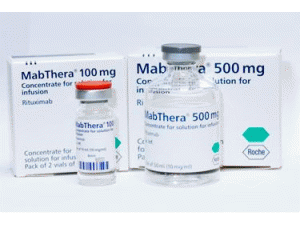利妥昔单抗,利妥昔单抗注射剂rituximab (Rituxan 500mg/50mL)
 药店国别:无
产地国家:美国
处方药:是
所属类别: 500毫克/50毫升/瓶
包装规格: 500毫克/50毫升/瓶
计价单位:瓶
生产厂家中文参考译名:无
生产厂家英文名:Roche/Genentech
原产地英文商品名:RITUXAN 500mg/50ml/Vial
原产地英文药品名:RITUXIMAB
中文参考商品译名:美罗华 500毫克/50毫升/瓶
中文参考药品译名:利妥昔单抗
曾用名:无
药店国别:无
产地国家:美国
处方药:是
所属类别: 500毫克/50毫升/瓶
包装规格: 500毫克/50毫升/瓶
计价单位:瓶
生产厂家中文参考译名:无
生产厂家英文名:Roche/Genentech
原产地英文商品名:RITUXAN 500mg/50ml/Vial
原产地英文药品名:RITUXIMAB
中文参考商品译名:美罗华 500毫克/50毫升/瓶
中文参考药品译名:利妥昔单抗
曾用名:无
简介
部份中文利妥昔单抗处方资料(仅供参考) 英文名:rituximab 商标名:Rituxan 中文名:利妥昔单抗 生产商:美国基因泰克公司 药品简介 Rituxan® (rituximab)为静脉输注美国初次批准:1997作用机制利妥昔单抗与抗原CD20特异性结合(人B-淋巴细胞-限制分化抗原,Bp35),位于前-B和成熟B淋巴细胞的一个疏水性跨膜蛋白有分子量约35 kD。抗原表达在>90% of B-细胞非霍奇金淋巴瘤(NHL)上,但在造血干细胞,前-B-细胞,正常浆细胞或其他正常组织上未发现抗原。 CD20 调节细胞周期启动和分化激活过程的早期几个步骤,而功能可能如同钙离子通道。CD20不从细胞表面脱落和不内化与抗体结合。在循环中没有发现游离的CD20抗原。B细胞被认为在类风湿样关节炎(RA)的发病机制中起作用和伴慢性滑膜炎。 在这个情况中,B 细胞可能作用于在自身免疫/炎症过程中多个部位,包括通过风湿样因子(RF)和其他自身抗体生成,抗原提呈,T-细胞激活,和/或促炎性细胞因子生成。 作用机制: 利妥昔单抗的Fab结构域结合至B淋巴细胞上CD20抗原,而在体外Fc结构域募集免疫效应器功能介导B-细胞溶解。细胞溶解度可能机制包括补体-依赖细胞毒性(CDC)和抗体-依赖细胞介导细胞毒性(ADCC)。在DHL-4人B-细胞淋巴瘤细胞株中抗体曾显示诱导凋亡。 正常组织交叉-反应性: 在胸腺,脾脏的白髓淋巴样细胞,和在外周血和淋巴结B淋巴细胞的大多数观察到利妥昔单抗结合。在检查的非淋巴样组织观察到很少或没有结合。 适应证和用途 Rituxan® (利妥昔单抗[rituximab])是一个指向CD20溶细胞抗体适用为以下患者的治疗: (1)非霍奇金淋巴瘤(NHL) (2)慢性淋巴细胞白血病(CLL) (3)类风湿样关节炎(RA)与氨甲喋呤[methotrexate]联用在有中度-至严重活动性对1种或更多TNF拮抗剂治疗反应不佳成年患者 (4)肉芽肿血管炎(GPA) (Wegener氏肉芽肿)和显微多血管炎(MPA) 在成年患者与糖皮质激素联用使用的限制:建议Rituxan不在有严重,活动性感染患者中使用. 剂量和给药方法 只作为静脉输注给药.不作为静脉推注或丸注给药.Rituxan只应由卫生保健专业人员给药与适当医学支持处理严重如它们发生可能致命性输注反应。 (1)对NHL的剂量为375 mg/m2. (2)对CLL在第一疗程剂量为375 mg/m2和在疗程2−6500 mg/m2,与氟达拉滨[fludarabine]和环磷酰胺[cyclophosphamide](FC)联用,每28天给予。 (3)作为Zeva lin® (Ibritumomab tiuxetan)的组分治疗方案剂量是250 mg/m2。 (4)对RA与氨甲喋呤联用剂量是两次-1000 mg静脉输注分隔2周(一个疗程)每24周或根据临床评价,但不快于每16周。建议每次输注前30分钟甲泼尼龙[Methylprednisolone]100mg静脉或等同糖皮质激素。 (5)对GPA和MPA与糖皮质激素联用的剂量是375mg/m2每周1次共4周。剂型和规格在单次使用小瓶100 mg/10 mL和500 mg/50mL溶液。 禁忌证:无。 警告和注意事项 (1)肿瘤溶解综合征:给予积极静脉水化,抗-高尿酸血症药物,监视肾功能。 (2)感染:不给Rituxan和开始适当抗-感染治疗。 (3)心律失常和心绞痛:严重或危及生命事件情况终止输注。 (4)肠梗阻和穿孔:考虑和对腹痛,呕吐,或相关症状评价。 (5)活病毒疫苗:Rituxan前或期间不要给予活病毒疫苗。 (6)血细胞减少:在常规间隔监视血细胞计数。 不良反应 (1)淋巴系统恶性肿瘤:NHL临床试验中常见不良反应(≥25%)是:输注反应,发热,淋巴细胞减少,畏寒,感染和乏力。CLL临床试验中常见不良反应(≥25%)是:输注反应和中性粒细胞减少。 (2)类风湿样关节炎(RA):在临床试验中常见不良反应( ≥10%):上呼吸道感染,鼻咽炎,泌尿道感染,和支气管炎。其他重要不良反应包括输注反应,严重感染,和心血管事件。 (3)肉芽肿血管炎(GPA)(Wegener氏肉芽肿)和显微多血管炎(MPA):在临床研究中常见不良反应(≥15 %)是感染,恶心,腹泻,头痛,肌肉痉挛,贫血,外周水肿。 药物相互作用 当与顺铂[cisplatin]联用时肾毒性。在特殊人群中使用 (1)妊娠:人数据有限;婴儿在子宫内暴露发生B-细胞淋巴细胞减少。 (2)哺乳母亲:当给予哺乳妇女时应谨慎对待。 (3)老年人使用:在CLL患者年龄大于70岁,探索性分析提示添加Rituxan至氟达拉滨[fludarabine]和环磷酰胺[cyclophosphamide](FC)无获益。 如何供应/贮存和处置 Rituxan小瓶[100 mg/10mL单次使用小瓶(NDC 50242-051-21)和500 mg/50 mL单次使用小瓶 (NDC 50242-053-06)]在2°C−8°C(36°F−46°F)时稳定。 不要使用超过在纸盒上标记失效日期。Rituxan小瓶应避免保护直接阳光。不要冻结或摇动。为输注Rituxan溶液可以贮存在2°C−8°C(36°F−46°F)共24小时。 为输注Rituxan溶液曾显示在室温稳定另外24小时。但是,因为Rituxan溶液不含防腐剂,已稀释溶液应贮存在冰箱(2°C−8°C)。Rituxan和聚氯乙烯或聚乙烯袋间未观察到不兼容性。英文版说明
Dosage and Administration GuideDescription and indicationRituxan is the first engineered antibody found to be effective and safe in the treatment of patients with relapsed or refractory low-grade or follicular, CD20+, B-cell non-Hodgkin's lymphoma (NHL).Preparing Rituxan for administrationThe recommended dosage of Rituxan is 375 mg/m2 given as a slow IV infusion once weekly for 4 doses (days 1, 8, 15, and 22)Rituxan is supplied in single-use vials containing 100 mg or 500 mg of Rituximab in a sterile, preservative-free solution at a concentration of 10 mg/mLRituxan vials should be stored at 2ºC to 8ºC (36ºF to 46ºF). Protect vials from direct sunlightUsing appropriate aseptic technique, withdraw the necessary amount of Rituxan and dilute to a final concentration of 1 to 4 mg/mL into an infusion bag containing 0.9% Sodium Chloride, USP or 5% Dextrose in Water, USP (see Dosage and Infusion Rate Finder). Gently invert the bag to mix the solution. Discard any unused portion left in the vialNo incompatibilities between Rituxan and polyvinylchloride or polyethylene bags have been observed. The compatibility of diluted Rituxan solutions with glass bottles has not been studiedAn IV saline line should be established and maintained throughout Rituxan administration. Rituxan should be administered through a side portDo not mix or dilute with other drugsIV pumps may be used. In-line filters may be used, but are not requiredParenteral drug products should be inspected visually for particulate matter and discoloration prior to administrationRituxan solutions for infusion are stable at 2ºC to 8ºC (36ºF to 46ºF) for 24 hours and at room temperature for an additional 12 hoursAdministration of RituxanRITUXAN SHOULD NOT BE ADMINISTERED AS AN IV PUSH OR BOLUSRituxan should be administered only by slow intravenous infusion using the rate indicated by the Dosage and Infusion Rate FinderPremedication with acetaminophen and diphenhydramine should be considered before each infusion and may attenuate infusion-related symptomsDosing and administration parametersThe recommended dosage is 375 mg/m2 given as a slow IV infusion once weekly for 4 doses (days 1, 8, 15, and 22)FIRST INFUSION: Initiate infusion at 50 mg/hour; if tolerated, escalate rate in 50 mg/hour increments every 30 minutes to a maximum of 400 mg/hourSUBSEQUENT INFUSIONS: Initiate at 100 mg/hour; escalate rate in 100 mg/hour increments every 30 minutes to a maximum of 400 mg/hour as toleratedFor patients who experience a severe hypersensitivity or infusion-related reaction, the infusion should be interrupted (see WARNINGS in full prescribing information)When the patient's symptoms completely resolve, the infusion may be continued at 50% of the rate prior to the reaction (see WARNINGS in full prescribing information)Adverse events and their managementAn infusion-related symptom complex consisting of fever (49%), and chills/rigors (32%), nausea (18%), asthenia (16%), and headache (14%) occurs in the majority of patients, generally within 30 minutes to 2 hours after the beginning of the first infusion— These reactions are generally mild to moderate and resolve with temporary interruption of the infusion and supportive care (IV saline, diphenhydramine, and acetaminophen)— The incidence of infusion-related events decreases with subsequent infusionsIn clinical trials, some patients experienced more severe events, including neutropenia (1.9%), leukopenia and thrombocytopenia (1.3% each), hypotension and bronchospasm (1.0% each), and angioedema (0.3%)Patients with preexisting cardiac conditions, including arrhythmias (n=4) and angina (n=1), have had recurrences of these events and should be monitored throughout the infusion and immediate postinfusion periodIn postmarketing surveillance, severe and sometimes life-threatening respiratory events have occurred— In patients experiencing severe infusion-related events, especially respiratory symptoms such as hypoxia, pulmonary infiltrates, or adult respiratory distress syndrome (ARDS), the infusion must be interrupted and the patient monitored closely until symptoms have completely resolved— Patients with high tumor burden or a high number (>50,000/mm3) of circulating malignant cells may be at higher riskRapid tumor lysis has been reported in patients with high numbers of circulating malignant lymphocytes— Patients with high tumor burden (bulky lesions) may also be at risk— Patients at risk of rapid tumor lysis should be followed closely and appropriate laboratory monitoring performed— Appropriate medical therapy should be provided if necessary— Subsequent Rituxan therapy has been administeredfollowing resolution of symptomsSince transient hypotension may occur, consideration should be given to withholding antihypertensive medications 12 hours prior to Rituxan infusionMedications for treatment of hypersensitivity reactions (eg, epinephrine, antihistamines, and corticosteroids) should be available for immediate use. Consideration should be given to having a physician available during the infusion用药温馨提示:当您服用此药物时,需定期接受医疗专业人士的检查,以便随时针对其药效、副作用等情况进行监测。本网站所包含的信息旨在为患者提供帮助,不能代替医学建议和治疗。
药品价格查询,专业药品查询网站,药品说明书查询,药品比价 » 利妥昔单抗,利妥昔单抗注射剂rituximab (Rituxan 500mg/50mL)
药品价格查询,专业药品查询网站,药品说明书查询,药品比价 » 利妥昔单抗,利妥昔单抗注射剂rituximab (Rituxan 500mg/50mL)


